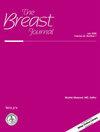lncRNA LUCAT1/ELAVL1/LIN28B/SOX2正反馈环促进三阴性乳腺癌细胞干性
IF 1.9
4区 医学
Q3 OBSTETRICS & GYNECOLOGY
引用次数: 4
摘要
背景三阴性乳腺癌(TNBC)作为乳腺癌(BC)的一个亚型,具有侵袭性。长链非编码rna (Long noncoding rna, lncRNAs)被证实参与了癌症的发生过程。lncRNA肺癌相关转录本1 (LUCAT1)已在多种癌症中被报道。研究了LUCAT1在TNBC中的作用及其潜在的调控机制。方法采用RT-qPCR检测LUCAT1的表达。通过功能实验揭示LUCAT1在TNBC中的作用。通过染色质免疫沉淀(ChIP)、RNA结合蛋白免疫沉淀(RIP)、荧光素酶报告基因和RNA拉下实验探讨了LUCAT1在TNBC中的潜在调控机制。结果LUCAT1在TNBC细胞中显著过表达。LUCAT1干扰阻碍TNBC细胞的干细胞性。SRY-box转录因子2 (SOX2)是LUCAT1的活性转录因子。LUCAT1募集ELAV-like RNA binding protein 1 (ELAVL1)蛋白稳定lin-28同源物B (LIN28B) mRNA,从而进一步调控SOX2表达,形成一个正反馈回路。结论lncRNA LUCAT1/ELAVL1/LIN28B/SOX2正反馈回路促进TNBC细胞的干细胞化。对TNBC干性机制的探索可能有助于TNBC的治疗。本文章由计算机程序翻译,如有差异,请以英文原文为准。
lncRNA LUCAT1/ELAVL1/LIN28B/SOX2 Positive Feedback Loop Promotes Cell Stemness in Triple-Negative Breast Cancer
Background Triple-negative breast cancer (TNBC), as a subtype of breast cancer (BC), features an aggressive nature. Long noncoding RNAs (lncRNAs) are proved to get involved in the processes of cancers. lncRNA lung cancer associated transcript 1 (LUCAT1) has been reported in multiple cancers. The role of LUCAT1 in TNBC and its latent regulatory mechanism were investigated. Methods RT-qPCR was performed to examine LUCAT1 expression. Functional experiments were implemented to disclose the role of LUCAT1 in TNBC. The underlying regulatory mechanism of LUCAT1 in TNBC was explored by chromatin immunoprecipitation (ChIP), RNA-binding protein immunoprecipitation (RIP), luciferase reporter, and RNA pull-down assays. Results LUCAT1 is significantly overexpressed in TNBC cells. LUCAT1 interference impedes cell stemness in TNBC cells. SRY-box transcription factor 2 (SOX2) is an active transcription factor of LUCAT1. LUCAT1 recruits ELAV-like RNA binding protein 1 (ELAVL1) protein to stabilize lin-28 homolog B (LIN28B) mRNA, thereby further modulating SOX2 expression, which forms a positive feedback loop. Conclusion The lncRNA LUCAT1/ELAVL1/LIN28B/SOX2 positive feedback loop promotes cell stemness in TNBC. The exploration of the mechanisms underlying TNBC stemness might be beneficial to TNBC treatment.
求助全文
通过发布文献求助,成功后即可免费获取论文全文。
去求助
来源期刊

Breast Journal
医学-妇产科学
CiteScore
4.00
自引率
0.00%
发文量
47
审稿时长
4-8 weeks
期刊介绍:
The Breast Journal is the first comprehensive, multidisciplinary source devoted exclusively to all facets of research, diagnosis, and treatment of breast disease. The Breast Journal encompasses the latest news and technologies from the many medical specialties concerned with breast disease care in order to address the disease within the context of an integrated breast health care. This editorial philosophy recognizes the special social, sexual, and psychological considerations that distinguish cancer, and breast cancer in particular, from other serious diseases. Topics specifically within the scope of The Breast Journal include:
Risk Factors
Prevention
Early Detection
Diagnosis and Therapy
Psychological Issues
Quality of Life
Biology of Breast Cancer.
 求助内容:
求助内容: 应助结果提醒方式:
应助结果提醒方式:


